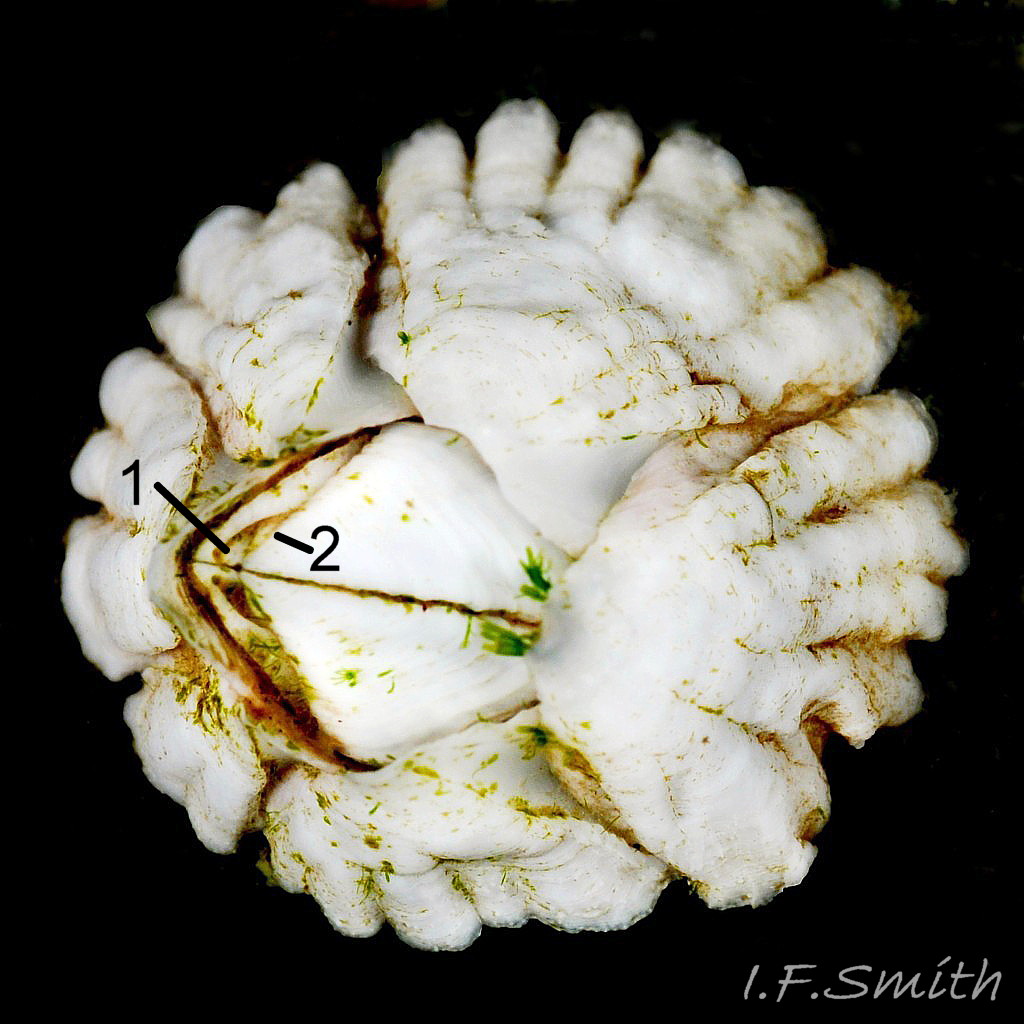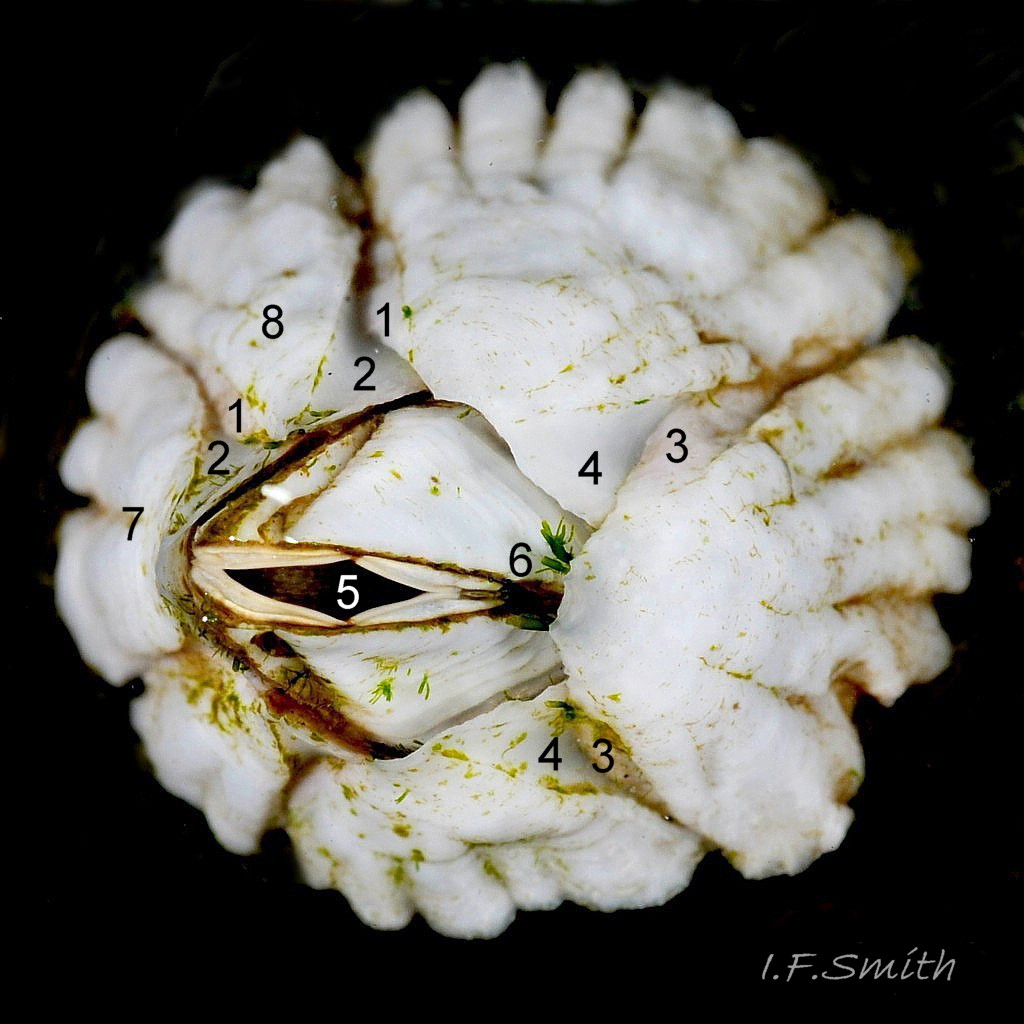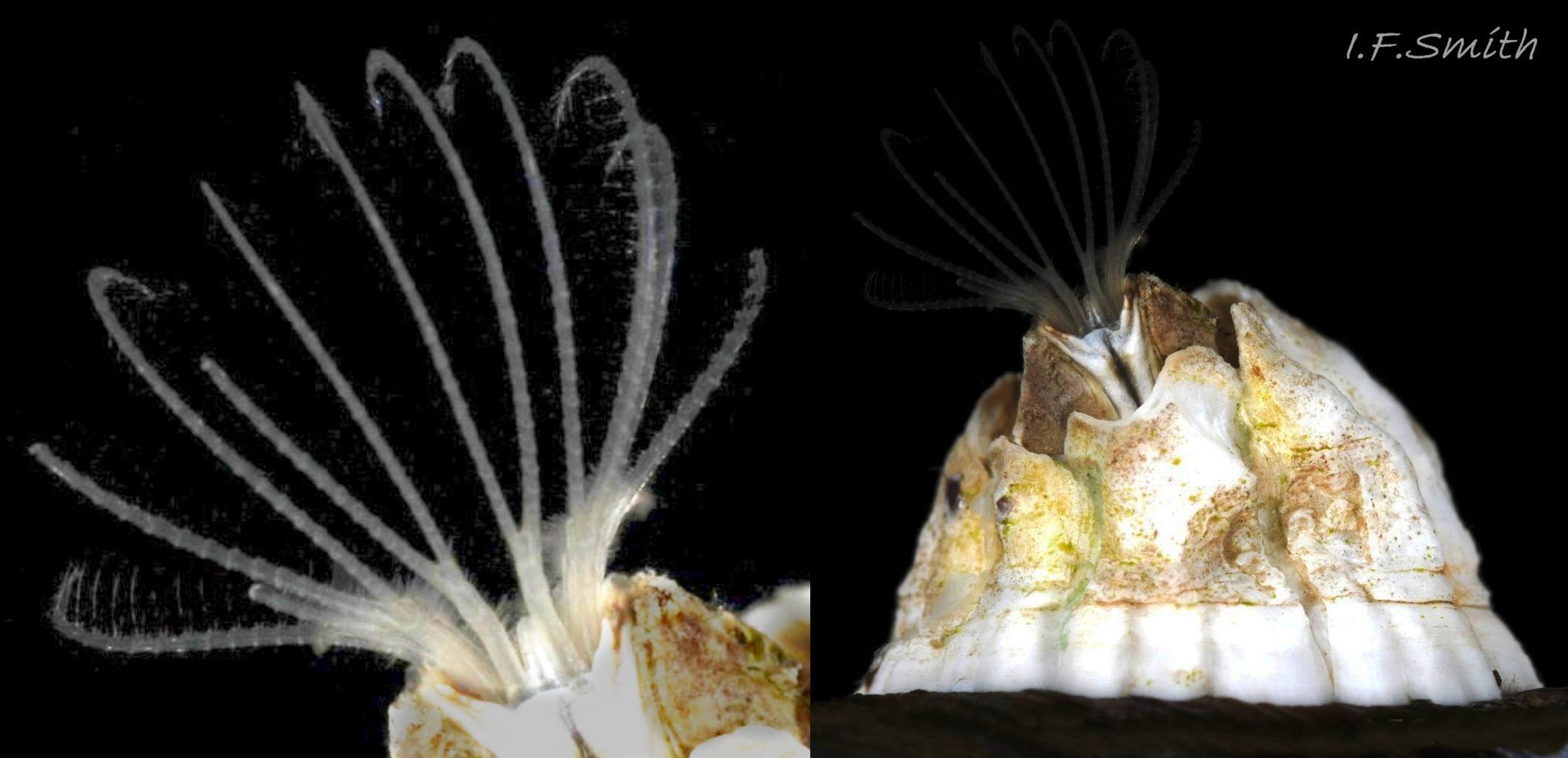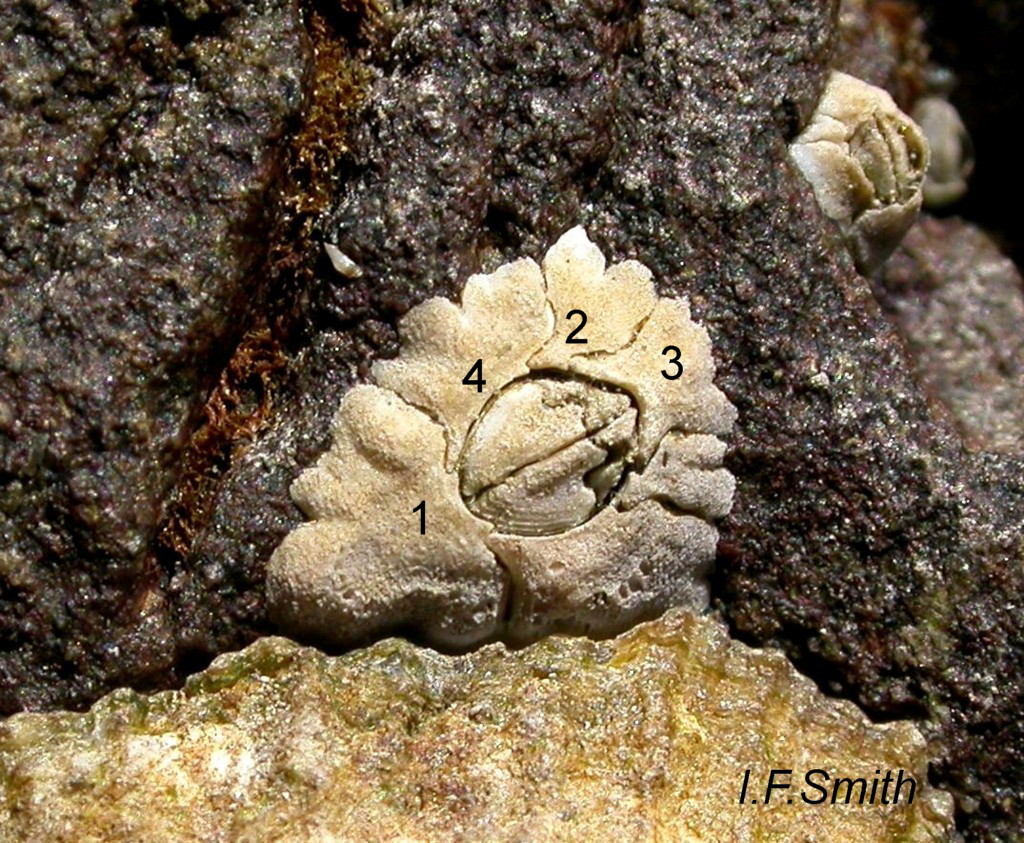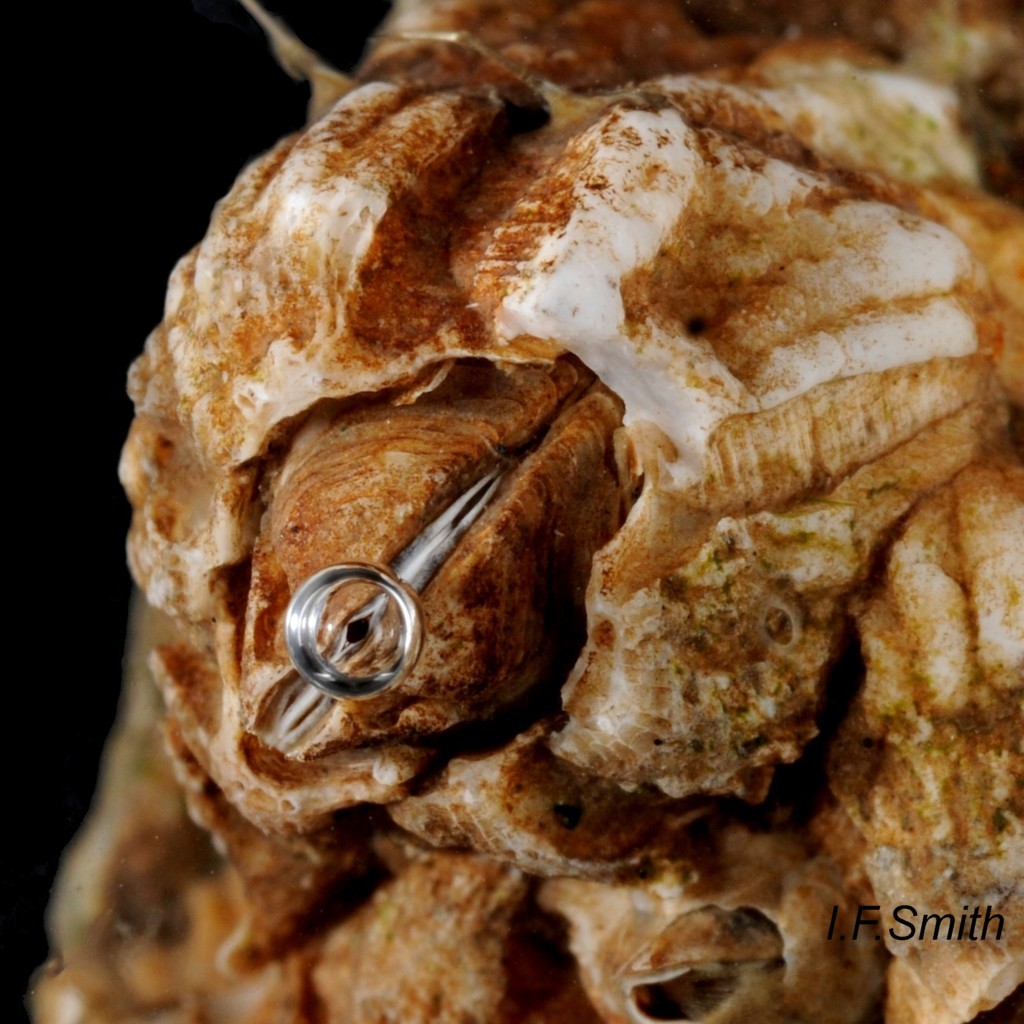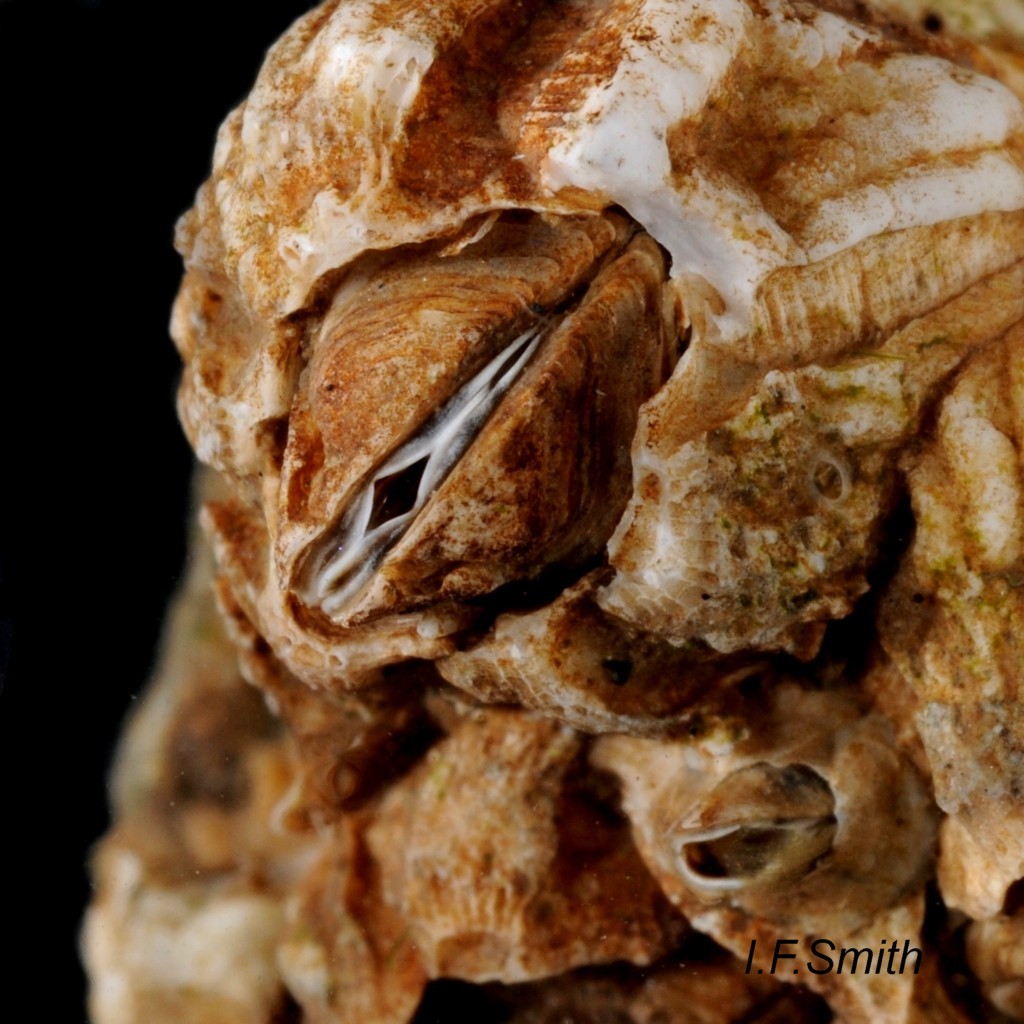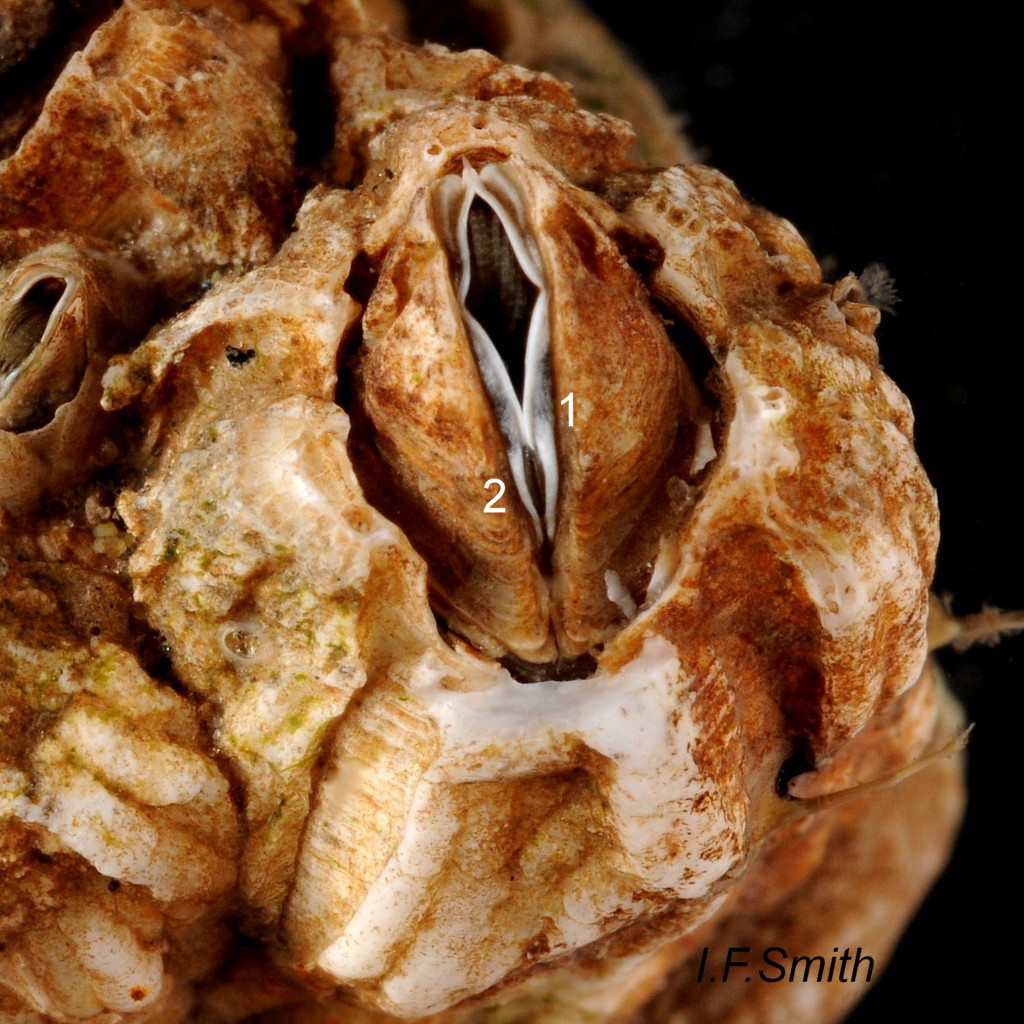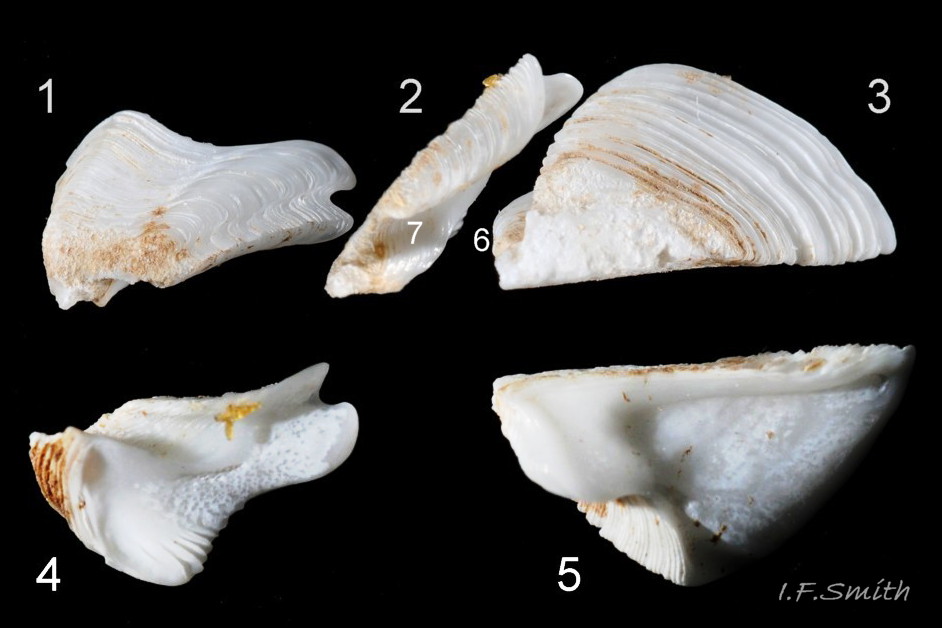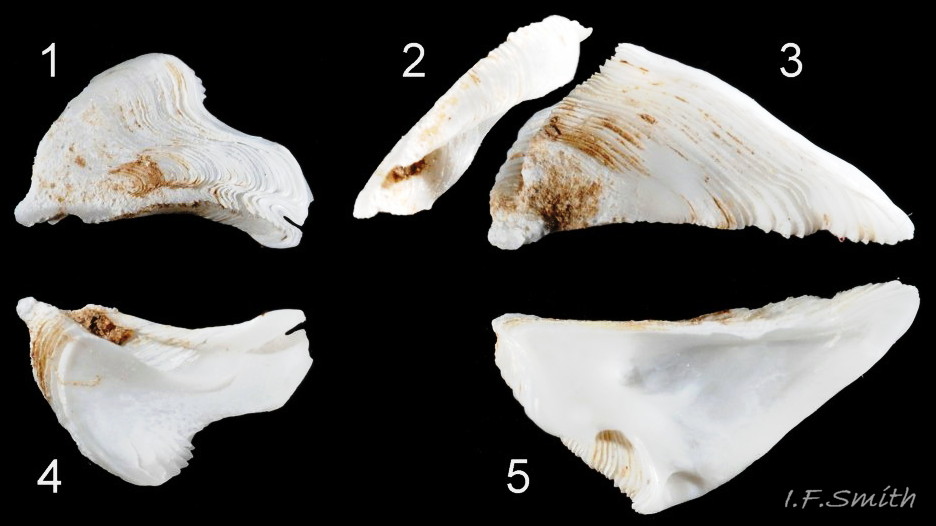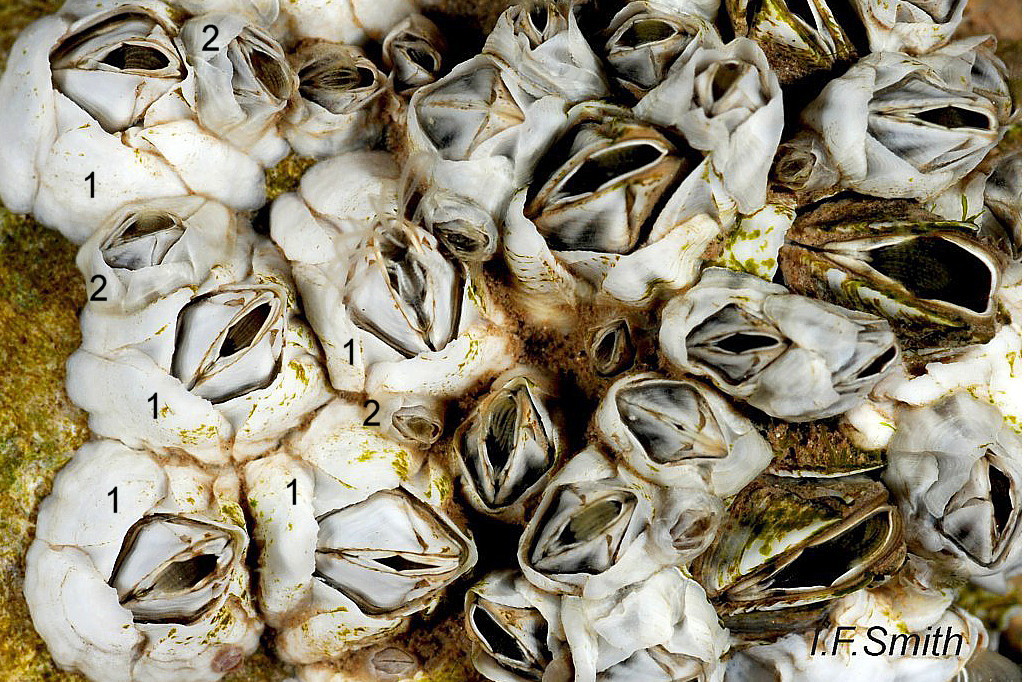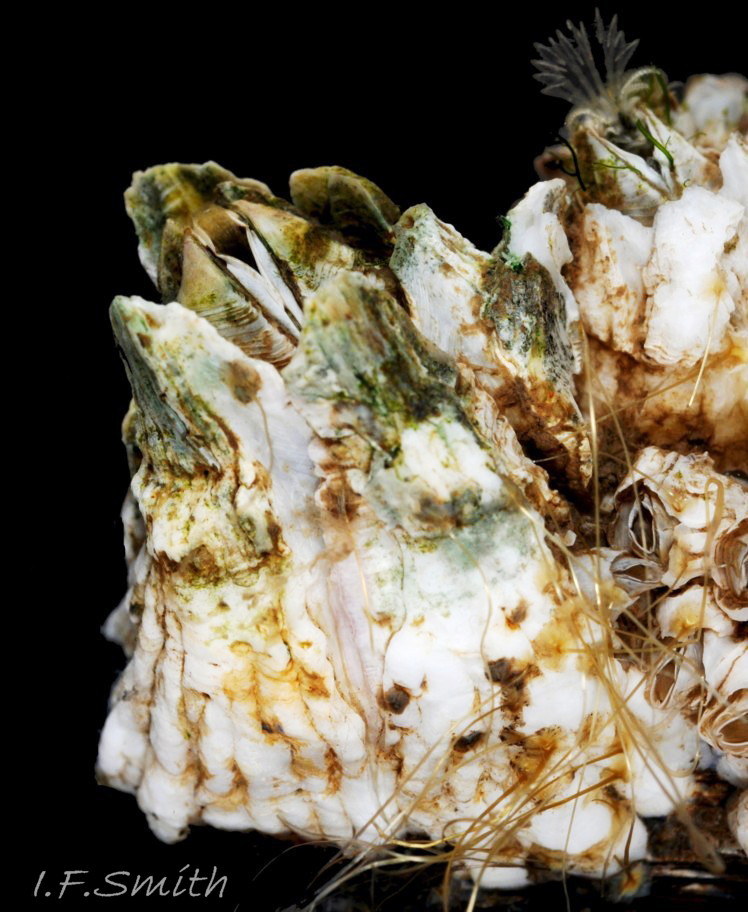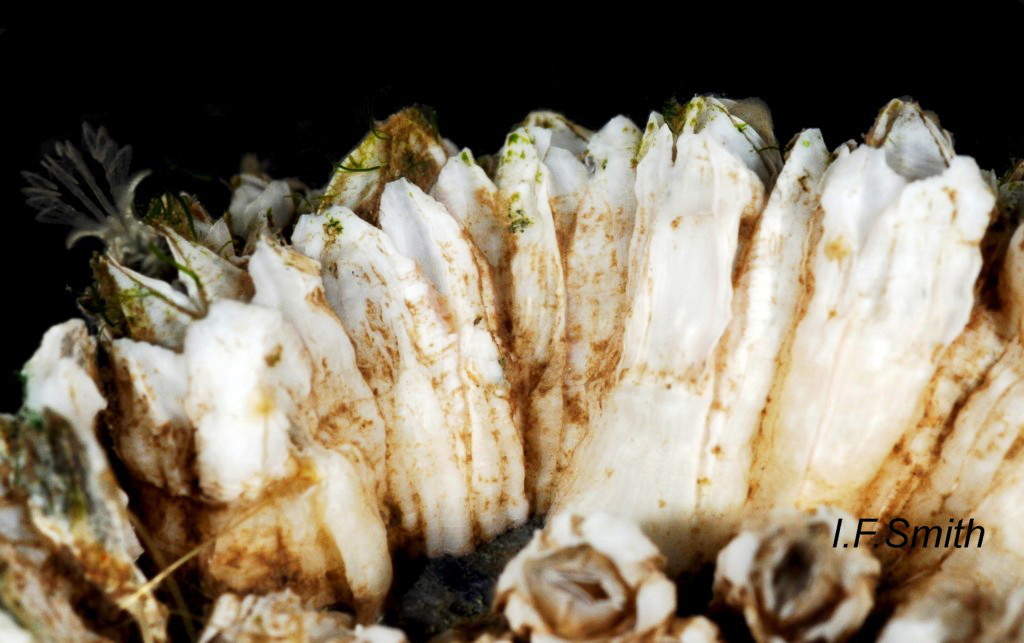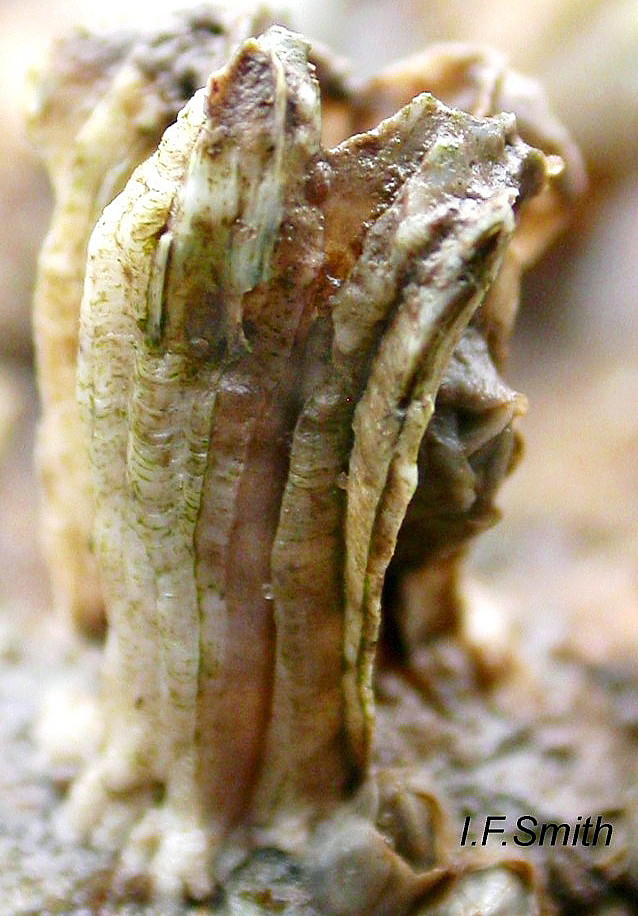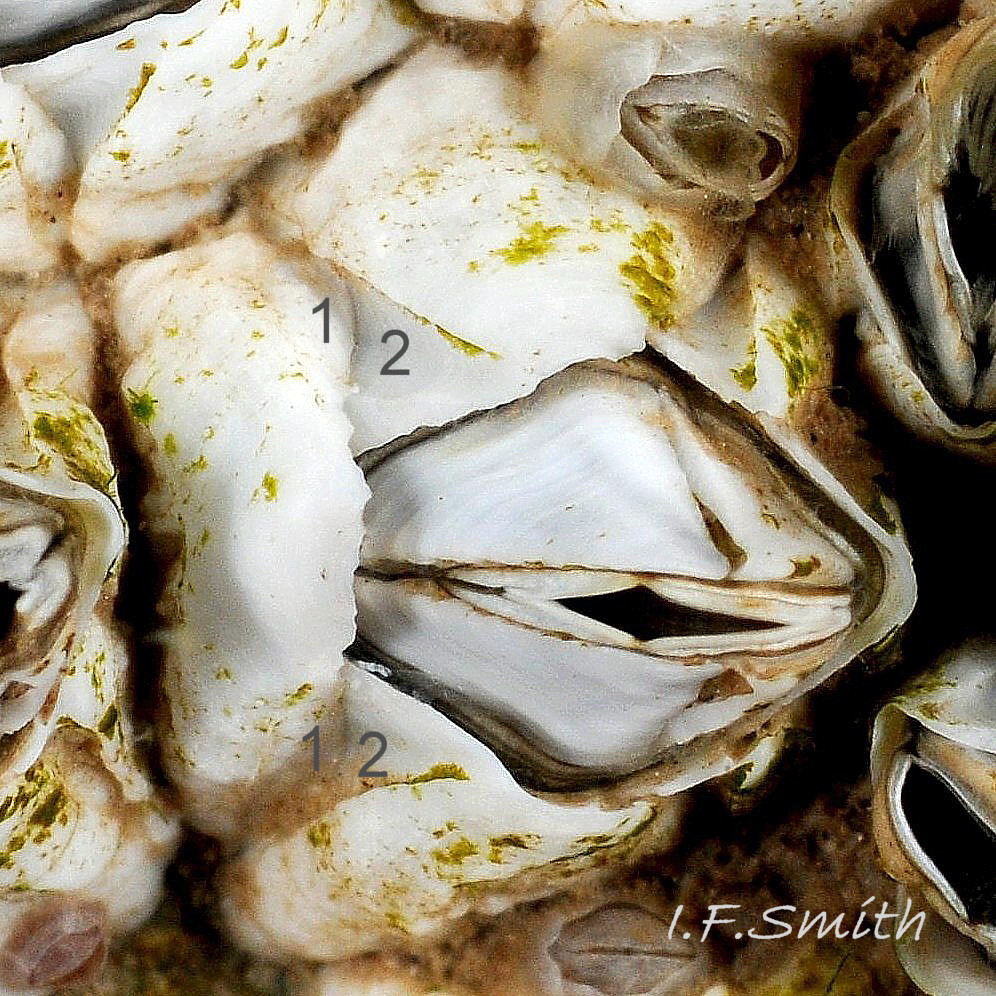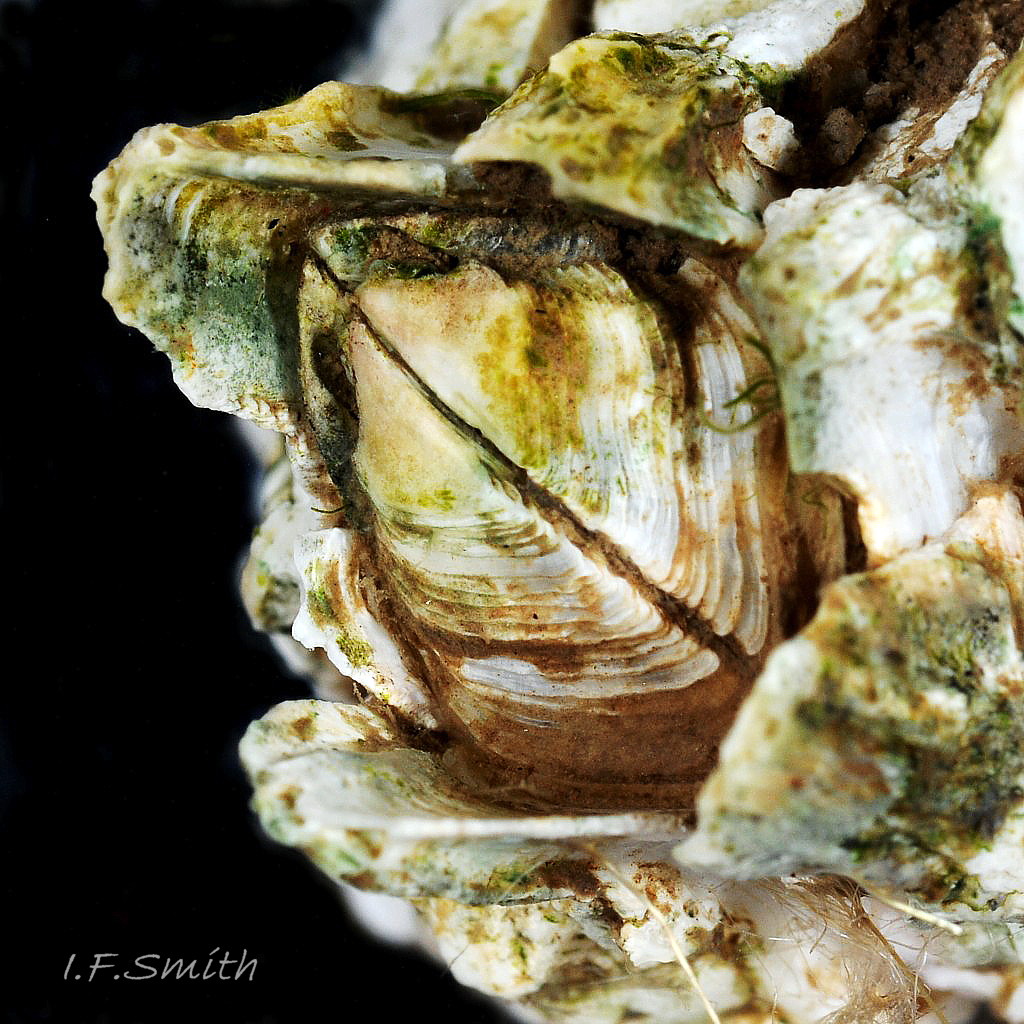Click image to enlarge with full caption. Main text below slider.
Semibalanus balanoides (Linnaeus, 1758)
text I.F. Smith
Current taxonomy: World Register of Marine Species.
www.marinespecies.org/aphia.php?p=taxdetails&id=106210
Synonyms: Balanus balanoides
Vernacular names
Northern rock barnacle, Crachen y Gogledd (Welsh).
DESCRIPTION (Glossary below).
opercular aperture (top opening)
Frequently described as diamond-shape (oblique equilateral parallelogram), but usually pentagonal [01 Semibalanus balanoides] , young may have almost oval aperture [04 Semibalanus balanoides], and eroded specimens may lack regular shape [07 Semibalanus balanoides]. (Author unable to find a distinct diamond to photograph among hundreds examined.)
opercular valves (lid plates)
Four valves; two terga and two scuta, which open along longitudinal midline with a tergum and scutum each side. Valves may be fairly smooth [15 Semibalanus balanoides], show strong growth lines [16 Semibalanus balanoides] or have them obscured by deposits [07 Semibalanus balanoides] which can be cleared by bleaching [08 Semibalanus balanoides] & [09 Semibalanus balanoides]. Tergum has cavity [01 Semibalanus balanoides] into which a protruberance of the scutum extends when operculum shut. Valves tilt up when operculum fully open [03 Semibalanus balanoides].
tergoscutal flap (membranous seal on lid plates)
White; sometimes slightly pinkish or yellowish [02 Semibalanus balanoides]. Between micropyle and rostral end, a patch of grey-black shading may be conspicuous [07 Semibalanus balanoides] or barely detectable [15 Semibalanus balanoides]. Small brown mark at micropyle [02 Semibalanus balanoides]; but can be faint and inconspicuous [15 Semibalanus balanoides]. Rim white, apart from micropyle mark and nearly 30% brown-black at rostral end [07 Semibalanus balanoides]. Usually no dark mark at carinal end [02 Semibalanus balanoides], but, when valves wide open, dark cleft between the two flaps may occasionally appear [11 Semibalanus balanoides] (bottom left).
wall plates
Six smooth [15 Semibalanus balanoides], ridged [02 Semibalanus balanoides] or heavily eroded [12 Semibalanus balanoides] plates with intervening triangular recessed alae and radii in upper half of wall when uneroded. Wide rostral plate overlaps ends of lateral plates [15 Semibalanus balanoides].
profile
When uncrowded, may form steep sided cone [03 Semibalanus balanoides] or a very low profile [04 Semibalanus balanoides]. When crowded, may grow into taller cone [12 Semibalanus balanoides], becoming columnar [13 Semibalanus balanoides] as crowding increases, and trumpet shape [14 Semibalanus balanoides] in extreme crowding.
base
Membranous, so no calcareous plate left on rock when barnacle removed.
diameter & height
Diameter to 10 mm, occasionally 15mm. Height when uncrowded to 8mm, but crowded columnar growth to 25mm (exceptionally 50mm) high.
Identifying features
**Aperture : Frequently described as equilateral diamond, but usually eroded to pentagon [01 Semibalanus balanoides] or irregular [07 Semibalanus balanoides]. Young may be oval [04 Semibalanus balanoides].
**Tergoscutal flaps : Rim white, apart from small brown micropyle mark and nearly 30% brown-black at rostral end [07 Semibalanus balanoides]. Dark mark in gap between flaps at carinal end only very occasionally seen (bottom left on [11 Semibalanus balanoides].)
**Wall plates: Six. Wide rostral plate overlaps ends of lateral plates [15 Semibalanus balanoides].
**Base plate: Membranous.
Salinity : Fully marine, and down to 20 p.p.t. in outer estuaries.
Similar species
Elminius modestus [07 Austrominius modestus]
**Aperture: Equilateral diamond, or pentagon.
**Tergoscutal flap: White rim has dark mark at each end, by micropyle and mid-way between micropyle and rostral end [07 Austrominius modestus] . (Dark mark at carinal end only visible when valves wide open.)
**Wall plates: Four, usually distinct. Wide rostral plate overlaps ends of lateral plates [07 Austrominius modestus].
**Base plate: Membranous.
**Salinity: Fully marine to very low salinity, reaching upper estuaries and tidal rivers.
Chthamalus stellatus
**Aperture: Approximately oval (juvenile S. balanoides may resemble it on exposed shores).
**Tergoscutal flap: White rim with bright orange mark at micropyle, orange wart at carinal end and orange-brown mark at rostral end [06 Chthamalus stellatus].
**Wall plates: Six. Narrow rostral plate overlapped by lateral plates [08 Chthamalus stellatus], but plates often fused and indiscernible.
Balanus balanus [08 Balanus balanus], B. crenatus [09 Balanus crenatus], and Amphibalanus improvisus [12 Amphibalanus improvisus] all have calcareous base plates .
Perforatus perforatus
**Aperture: Small, oval or drop shape. (Larger on eroded and crowded ones)
**Tergoscutal flaps: purple-brown with patches of bright blue and white.
**Wall plates: Usually some pink or purple marks. Regular cone.
**Base plate: Calcareous but fragile, so doesn’t persist long after barnacle removed.
Near low water mark.
ECOLOGY
On British shores, usually the commonest intertidal barnacle; withstands drying out and terrestrial extremes of temperature. At low tide, breathes atmospheric air through micropyle in tergoscutal flap [06 Semibalanus balanoides]. When tide returns, expels air as a bubble [05 Semibalanus balanoides] through the micropyle and extracts oxygen from water with gills. Sheltered and exposed shores at full salinity down to 20p.p.t. so found in lower estuaries. In Britain, commonest around mid-tide level, extending up to MHWN or higher, scarce sublittorally and rarely on floating objects, but sublittoral in Greenland.
Columnar growth is usual reaction to crowding. Overgrowing and ball accumulations rare. In places being supplanted by Elminius modestus which breeds more frequently, filling any vacant spot and settling on and overgrowing S. balanoides [11 Semibalanus balanoides].
DISTRIBUTION
All round Britain and Ireland on hard substrate. See NBN map:
species.nbnatlas.org/species/NBNSYS0000042568
In Atlantic, from Arctic to Gironde, France and to Cape Hatteras, USA. In Pacific, from Arctic to Amur and British Columbia. See GBIF map: www.gbif.org/species/2115784
GLOSSARY
ala – (pl. alae) side flange of wall plate, overlapped by radius of next plate.
carina – posterior wall plate adjoining the smaller pair of lid plates (terga). carinal – (adj.) of the carina.
cirri – (sing. cirrus) feather-like thoracic limbs used in filter feeding.
cypris – (pl. cyprids) final larval bivalved stage in barnacle development.
euryhaline – tolerant of wide range of salinities.
HW- high water level.
HWS- level of high water spring tide.
lateral plates – wall plates other than end plates (depending on sp., strictly may be rostro-lateral or carino-lateral).
LWN- level of low water neap tide.
micropyle – small breathing/sensing hole between tergoscutal flaps, sometimes visible when operculum shut. Found on spp. that are left out of water for long periods.
MLWS- level of mean low water spring tide.
MTL – mid-tide level.
opercular – (adj.) of the operculum (aperture lid).
operculum – moveable lid-like structure used to close the aperture.
paries – ( pl. parietes) central section of wall plate, flanked by alae and radii.
ppt – parts per thousand (of salt in water).
radius – (pl. radii) side flange of wall plate, overlaps ala of adjacent plate.
right – on right when barnacle viewed from above with rostrum at 12 o’clock.
rostral – (adj.) of the rostrum.
rostrum – anterior wall plate adjoining larger pair of lid plates (scuta). (Lost on Austrominius and balanoids; place taken by fused rostro-laterals; referred to as rostrum for simplicity.)
scuta – (sing. scutum) the larger plates of the operculum (lid).
sessile – (adj.) permanently attached to substrate (of immobile organism).
stenohaline – unable to tolerate much variation in salinity.
terga – (sing. tergum) the smaller plates of the operculum (lid).
tergoscutal flaps – membranous “lid seals”, (most visible as valves start to open).
Rainbow, P.S., 1984. An introduction to the biology of British littoral barnacles. Field studies 6: 1-51.
fsj.field-studies-council.org/media/350581/vol6.1_161.pdf
Scrosati RA, Ellrich JA (2016). A 12 year record of intertidal barnacle recruitment in Atlantic Canada (2005 to 2016): relationships with sea surface temperature and phytoplankton abundance. PeerJ 4:e2623 peerj.com/articles/2623/
Southward, A.J., 2008. Barnacles. London, Linnean Society.
Fouling-Atlas association, Germany. www.fouling-atlas.org/
